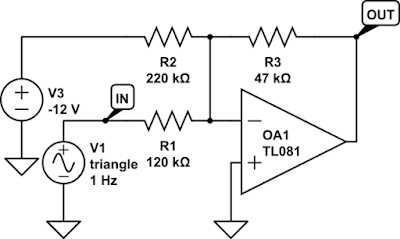The I/O Module is a 6 HP module that provides some input and output facilities. The black knob is a double potentiometer that controls the left and the right channels. If a cable is plugged into the gold jack it will be either the left channel or both channels, and a cable plugged into the purple jack will be the right channel. The output is a TRS jack with the black dial controlling the volume. It uses two NE5532 OPAMP, one for each channel. The input voltage is divided by 5 using a resistor network. Because a dual voltage system is used, there is no output capacitor to normal the voltage.
The bottom six jacks are all MIDI related. The MIDI input is fed to the board from the rear of the box using a special conversion circuit (shown below. The 10k resistor in this circuit is essential and occasionally missing in online versions of this circuit). The optocoupler prevents ground loops through the MIDI cable and is required by the MIDI protocol for receiving data. There are two headers on the module, one to provide power to this circuit and one to transfer the MIDI signal to the PIC16F690 that is used to convert the MIDI.
The PIC16F690 was chosen because it has an USART (for MIDI) an analog input and a PWM that can be used as an analog output, and it can be programmed by the PICkit 2. The MIDI outputs are, in order: CV out for MIDI notes played on channel 4. The gate signal of these MIDI notes. The clock signal of the MIDI, and three drums from channel 10. The source code for the MIDI is available here.
To ensure a quick response to frequency changes the PIC16F690 is running at 20Mhz, which also allows 10-bit accuracy. There's a two pole active filter to prevent the PWM signal from interfering with the output, and a small trim potentiometer that allows setting the output voltage from 1x to 2.1x (10k with 9.1k non-inverting OPAMP, which may not be enough).




.png)



.png)








